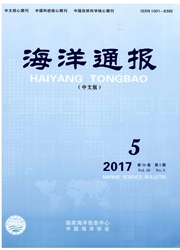

 中文摘要:
中文摘要:
采用基于有限体积法和非结构化网格的三维潮流模型,同时耦合拉格朗日粒子追踪模型和保守污染物输运扩散模型。模拟了大连湾内的水动力变化、潮致余流场分布、保守污染物的输移和特征粒子的运动轨迹;同时研究了不同人工岛对湾内污染物迁移的影响。模拟的潮流场与实测数据吻合较好。结果表明:湾内潮致余流呈顺时针半涡形态,湾口潮致余流呈NE方向;湾内保守污染物主要随潮致余流的方向而迁移,湾口的迁移扩散快于湾中,湾内北部的污染物能较快扩散到湾外,湾内南部的污染物易在湾底滞留,各个子湾内的污染物不宜扩散出来;两种方案人工岛均会降低臭水套湾和香水套湾的自净能力,且方案2比方案1的影响大;而对红土堆子湾方案1的影响比方案2大,且方案2能改善其水质情况。
 英文摘要:
英文摘要:
Based on an unstructured grid, finite-volume coastal ocean model and coupled the Lagrangian particle tracking model and the conservative pollutant transport diffusion model, the hydrodynamic change, the tidal-induced residual current, the conservative pollutant transport, the trajectories of characteristic particles and different artificial islands influence on conservative pollutant transport were simulated. It was verified that the results of the ocean model agreed well with the field observed data. The results showed that tidal-induced residual current presented the form of clockwise semi- vortex flow; the direction of residual current in the bay estuary was NE, and the direction of conservative pollutant migration was the same as the residual current direction; the self-purification capacity of conservative pollutants in the bay estuary was better than that in the bottom, and such capacity in the northern bay was better than that in the southern hay; the pollutant in the sub bays was difficult to diffuse out. Both of artificial island scenarios would reduce the seff-purification capacity of the Xiangshuitao Bay and the Choushuitao Bay, and the impact of scenario 2 was greater than that of scenario 1 ; the artificial island 1 would also reduce the self-purification capacity of the Hongtuduizi Bay, but scenario 2 would improve its water quality.
 同期刊论文项目
同期刊论文项目
 同项目期刊论文
同项目期刊论文
 Using a time-domian higher-order boundary element method to simulate wave and current diffraction fr
Using a time-domian higher-order boundary element method to simulate wave and current diffraction fr Identification of hydrodynamic coefficients from experiment of vortex-induced vibration of slender r
Identification of hydrodynamic coefficients from experiment of vortex-induced vibration of slender r Laboratory observations of wave evolution, modulation and blocking due to spatially varying opposing
Laboratory observations of wave evolution, modulation and blocking due to spatially varying opposing Laboratory tests of vortex-induced vibrations of a long flexible riser pipe subjected to uniform flo
Laboratory tests of vortex-induced vibrations of a long flexible riser pipe subjected to uniform flo A three-index estimator based on active thermometry and a novel monitoring system of scour under sub
A three-index estimator based on active thermometry and a novel monitoring system of scour under sub Application of Multiscale Fiber Optical Sensing Network Based on Brillouin and Fiber Bragg Grating S
Application of Multiscale Fiber Optical Sensing Network Based on Brillouin and Fiber Bragg Grating S Numerical analysis on ultimate pullout bearing capacity of drag embedment anchor based on elastic-pl
Numerical analysis on ultimate pullout bearing capacity of drag embedment anchor based on elastic-pl Scour monitoring system of subsea pipeline using distributed Brillouin optical sensors based on acti
Scour monitoring system of subsea pipeline using distributed Brillouin optical sensors based on acti 期刊信息
期刊信息
